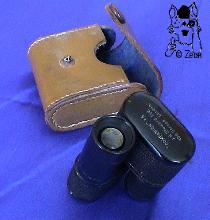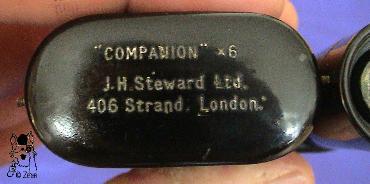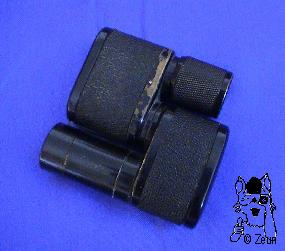Faltmonokular "Companion x6"Dieses Faltmonokular der Londoner Optiker-Firma J.H. Steward (406 Strand) mit der Bezeichnung "Companion x6" könnte aus der 2. Viertel des 20. Jh. stammen – J.H. Steward existierte ca. von 1850 bis zum 2. Weltkrieg. Auf dem kleinen Lederfuteral wurde "RL from EL Sept 1936" eingeritzt, was auf das Kauf- oder Verschenkdatum hinweisen könnte. Es funktioniert nach dem 90°-Faltprinzip des "Turmon". Da das Turmon ab 1921 hergestellt wurde und als erstes seiner Art gilt, müsste dies ein Nachbau von Steward sein. Bei H. Seeger "Ferngläser, ..." (S. 41) ist ein baugleiches Binokular "The Folding Minim" abgebildet, das bereits von 1915 (!) stammt. |
Folding Monocular "Companion x6"This folding monocular by the optician J.H. Steward (406 Strand, London) is named "Companion x6". It probably dates from the second quarter of the 20. c. – J.H. Steward produced optical instruments between 1850 to WWII. The words "RL from EL Sept 1936" are scratched onto the small leather case. The date could hint to the year of purchase or giving away. Based on the "90 degrees folding" porro prism system of the "Turmon", it must be a reproduction of the Turmon which was introduced 1921 and is supposed to be the first of its kind. In H. Seeger "Ferngläser,...." (p.41) the "Folding Minim", a binocular of the same design, is depicted and said to be from 1945 (!). |


Das Monokular hat eine Vergrößerung von 6fach bei einem Objektivdurchmesser von 13mm. |
The monocular has 6 times power with a objective aperture of 13mm Dimensions are 60x65x22mm when unfolded and 6x40x40mm when folded. The black painted brass monocular weighs 143g. |


Im Gegensatz zu den heutigen Faltmonokularen wird die Fokussierung/Dioptrienausgleich am Objektiv justiert (s. geriffeltes Ende im Foto). |
Contrary to today's folding monoculars, focussing is done by turning the objective tube (see grooved/roughened tube in the pic.) The eye lens is blurred by yellow stains. |
Fotos: Zeun

